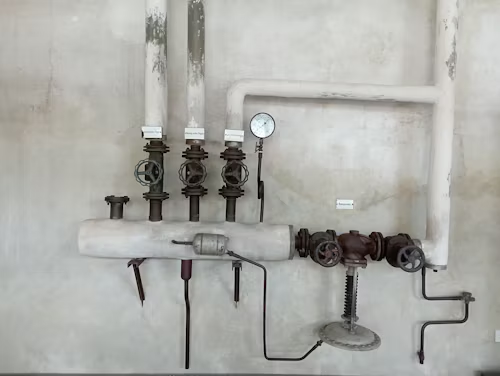Having clean water is vital for your health. A backflow prevention device prevents contaminated water from entering your clean water supply. It works by allowing water to flow in one direction. When the pressure drops, it shuts off. It keeps your water safe from germs and chemicals. These devices are required for houses and businesses.
What Is a Backflow Prevention Device?
A backflow prevention device prevents dirty water from flowing back into the drinking water supply. It prevents the spread of chemicals and bacteria. Plumbing codes require these devices in homes and businesses.
Motive Causes for Backflow
Numerous instances lead to backflow occurrence, such as:
- The rupture of a water main
- Hydrant utilisation in such a vicinity
- Mechanical breakdowns of pumps
- High utilisation rate resulting from commercial irrigation systems
The impact of these scenarios causes the pressure inside the clean line to drop lower than that of contaminated waters, allowing the dirty water to be sucked in. If a backflow prevention valve is not present, this impure water will flow into your faucets.
What Constitutes Backflow Protection in Plumbing?
Backflow prevention plumbing utilises devices positioned to block any possibility of backflow throughout the entire water system serving residential areas, as well as businesses, factories, and municipal supplies.
Some of these devices include:
- Air gaps
- Double check valves (DCVs)
- Reduced Pressure Zone (RPZ) Valves
- Pressure vacuum breakers (PVBs)
They all serve special functions assigned to them based on hazard levels, in addition to system arrangements.
Backflow Prevention Device for High Hazard Levels
Some incidents come with higher contamination threats, such as in chemical manufacturers, fertiliser using irrigation systems, or healthcare centers, whereby there is a need for a high-hazard backflow prevention device.
Devices like RPZ valves prevent dangerous backflow. Have a plumber check if you need one. UR Plumber assesses, installs, and maintains backflow devices to keep your water safe.
Signs You Need Backflow Protection
Be alert for these reasons:
- Irrigation or sprinkler systems
- Fire suppression systems
- Using bore or private water sources
- Frequent changes in water pressure
- Old municipal systems
Install backflow devices for safety if any of these apply.
Testing and Maintenance for Backflow Devices
Backflow valves require annual testing as per local rules. Regular checks keep them working properly.
Maintenance tasks include:
- Testing by licensed plumbers
- Replacing worn parts
- Cleaning sediment buildup
UR Plumber handles testing and maintenance for homes and businesses, ensuring compliance and safety.
DIY vs Professional Installation
Do not attempt to install a backflow prevention device yourself. These devices are critical for public health and must be installed by a licensed plumber. A poorly installed device can fail during pressure variations, which can cause unsafe water to flow in.
UR Plumber has certified technicians to ensure proper installation as per local regulations. This will provide peace of mind when it comes to water safety.
Benefits of Installing a Backflow Prevention Valve
The installation of a backflow valve has many advantages:
- It safeguards health by preventing dangerous contaminants from entering drinking water.
- It satisfies legal standards set by authorities regarding water safety.
- It provides confidence that unexpected contamination risks are minimized.
- It enhances safety as well as reliability within homes or businesses.
- It may assist in insurance claims related to plumbing emergencies.
Conclusion
Clean and safe drinking water is very vital hence having a good backflow prevention installed is simply yet powerful way of making sure it remains so. Be it at home or in business premises, installing correct type prevents like sewage, chemical or irrigation water getting into taps. Do not be uncertain about your water standards. You should take safe water precautions and do the upkeep needed for your plumbing systems. UR Plumber is prepared to guide you if you have any questions or concerns about your needs.
This guide has shed light on several aspects regarding backflow system, such as what type of device is appropriate under certain conditions and the frequency for testing thereof, by giving you proper insight.
Do You Need Assistance for Your Backflow? Contact Us!
UR Plumber is to provide skilled solutions for plumbing, including placing, taking care of, and examining backflow preventers in Tamahere and the Waikato region. Call us at 027 856 7712
Frequently Asked Questions
What is a backflow prevention device?
A backflow prevention device prevents the reverse flow of contaminated water into the clean supply. It is vital for ensuring safe drinking water. UR Plumber installs and services these devices to protect you and your home.
Why is backflow prevention important?
When there is no protection against backflow, contaminants such as sewage, chemicals, and irrigation water can enter clean water lines. This can affect health negatively. UR Placenta can help you select the appropriate backflow prevention device for your plumbing system.
How to determine if a high-hazard backflow prevention device is needed?
If your property uses chemicals, medical waste, or industrial water, a high-hazard backflow prevention device must be installed. Contact UR Plumber for a risk assessment.
What is the frequency of testing the backflow device?
Most local councils want an annual test for backflow prevention devices to be done. It ensures they function well and meet both regulations. UR Plumber offers certified testing services, along with comprehensive documentation.
What happens when the backflow valve fails?
A failed valve can result in contaminated water entering homes, hence affecting drinking, bathing, as cooking water. To prevent this from happening, UR Plumber offers emergency inspections so that they can replace them quickly.

